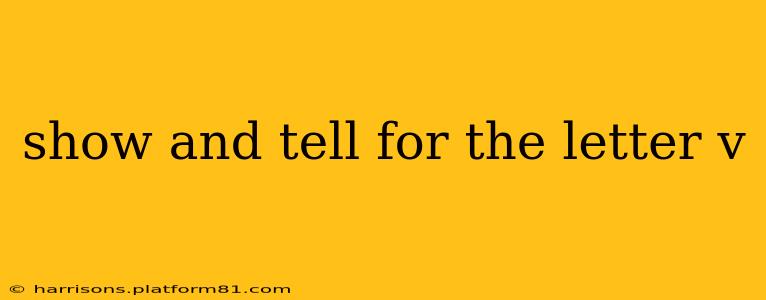The letter V, a dynamic and versatile character in the alphabet, holds a special place in the world of language and learning. This guide offers a comprehensive "show and tell" experience, exploring the letter V through various engaging activities and insightful information. Whether you're a teacher preparing a lesson, a parent helping a child learn, or simply curious about the letter V, this guide is for you.
What Sounds Does the Letter V Make?
The letter V typically makes one primary sound: the /v/ sound as in "van" or "very." However, it's crucial to note that the sound can vary slightly depending on the surrounding letters and the accent. For example, in some dialects, the V sound might be slightly more voiced or unvoiced. This subtle variation is perfectly normal and a testament to the richness of spoken language.
Show Me the V: Visual Representations
Let's dive into the visual aspects of the letter V. The lowercase 'v' is a simple yet elegant character with its pointed downward strokes. The uppercase 'V' is bolder and more assertive, often used to create emphasis or represent important things.
Activities for Visual Learning:
- Tracing and Writing: Trace uppercase and lowercase Vs repeatedly to improve letter recognition and writing skills.
- Shape Recognition: Use playdough, building blocks, or even your fingers to create the shape of the V.
- Visual Searches: Find objects and pictures around the house or classroom that start with V, reinforcing the association between the letter and its related words. Think of vegetables, vehicles, or even the letter itself as part of a logo or design.
Tell Me About V: Vocabulary and Words
Now, let's explore the words that begin with V. The letter V opens the door to a fascinating array of vocabulary!
Vocabulary Building Activities:
- V-Word Collection: Create a list of words that begin with V. Categorize them (e.g., vehicles, vegetables, verbs) to enhance understanding and memory.
- Storytelling: Compose a short story using as many V-words as possible, fostering creativity and language development.
- Picture Matching: Match pictures of objects with their corresponding V-words, making the learning experience visually engaging.
Frequently Asked Questions (FAQs)
What are some common words that start with the letter V?
Many common words begin with V! Consider words like "van," "very," "vegetable," "violet," "vacation," "video," "visit," and "voice." The possibilities are vast and varied!
How can I make learning the letter V fun for children?
Learning should be fun! Incorporate games, songs, and interactive activities. Use colorful visuals, engaging stories, and hands-on projects. Make it a collaborative experience, involving the child in the learning process.
What are some real-world examples of the letter V?
Look around! You'll find Vs in many places. The letter V itself is a visual example. Consider the shape of a V-neck shirt, the point of a victory sign, or the shape of some road signs. The possibilities are virtually endless.
Are there any interesting facts about the letter V?
The letter V has a rich history, evolving from the Latin alphabet. Its shape has remained relatively consistent throughout time. In some languages, its pronunciation might differ, adding another layer to its fascinating linguistic journey.
Conclusion: A Victorious Voyage with V!
This "show and tell" experience for the letter V has hopefully showcased the letter's versatility and significance. By utilizing a variety of visual aids, vocabulary-building exercises, and engaging activities, learning the letter V becomes an enriching and memorable adventure. Remember to adapt these strategies to suit the specific learning style and age group, ensuring a fun and effective learning process for everyone.
